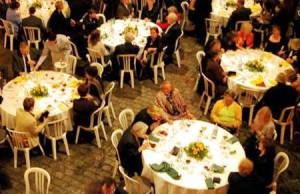Cooking for a Crowd on a Budget
The thought of cooking for a crowd evokes visions of massive quantities of food. That is a reality. Meals prepared for family reunions, wedding receptions, community fundraisers and school functions are grand affairs accompanied by grand food costs! Yes, you will spend a pretty penny..but its all relative.

Low cost cooking requires a cool head as you draw up the budget. It is very easy to be thrown off track if you plan a simple party but fantasize about a luxurious event.
When your budget is set...STICK TO IT! The crowd you are cooking for can be anywhere from 10 to 1000. All the same, cooking for a crowd on a budget is no different than cooking for a family of four with limited resources.
Crunch the Numbers
First, have a solid idea of the amount of money that is available for food only, including oils and all other seasonings. Things like plates, flatware, tables, chairs and decorations should be calculated separately in order to know exactly how much money will be allocated for the food.
Once you have that number, divide it by the number of guests. In addition, it makes good sense to reserve about 2-5% of your funds for miscalculations, cooking disasters and general emergencies.
For example, you have $800 to feed 150 people. Subtract $40.00 for emergencies and divide 760.00 by 150. The result is about $5.00 per person.
This is where you start to plan the menu and estimate food quantities and costs. Consider the types of tasty, healthy and low cost foods with which you are already familiar.

With this budget, specialty meats such as lamb and veal are out of the question. Shrimp, crab and scallops are also a no go. Chicken, pork and some cheaper beef cuts are good considerations especially if you purchase whole cuts and prepare them yourself.
Careful Menu Planning
Careful menu planning is super important when cooking for a crowd on a budget. The time of day and type of meal has an effect on how much money you will spend. Breakfast foods are less expensive then lunch and dinner foods and people will expect less “fancy” fare. Also, dinner has a special occasion feel to it and your quests will expect more.
Deciding the portion size per guest is another way to control costs when cooking on a budget. Two pieces of roasted chicken thighs and/or legs is a reasonable serving size, especially if the pieces are large.
It is a good idea to decide on the main course or meat entrée first and then decide side dishes, breads and desserts based on the remaining dollars. The main course is usually what everyone will eat, while side dishes may be arbitrarily selected. You might also serve a huge entrée and minimize the number of other dishes, such as a vat of chili accompanied only by cornbread, butter and a simple salad.
Additionally, the best way to control portions is to have volunteers serve the food to the guests. Guests will be less likely to take issue with the number of allotted pieces of chicken (or serving of green beans for that matter) if a friendly, smiling face is dishing it up.
Shop Wisely
Food prices vary by locale, but as an example, chicken thighs purchased in bulk cost about $2.25 per pound. Using a food quantities chart you know that you will need about 100 pounds of chicken to feed 150 people, 2 pieces of chicken each. That comes to about $225.00 for the chicken costs.
Starting with the $800 from above example minus the $40 for emergencies, that leaves you with $535.00 for the side dishes and dessert.
That is a reasonable amount of money if your side dishes include simply prepared staples such as rice, potatoes and pasta and veggies like carrots and green beans (do a price comparison of fresh vs. frozen).
Also, shopping for produce based on the season is a smart way to save money. Your local farmers market is a great place to investigate the best buys. The produce manager at your favorite grocery store is also a valuable resource.
Obviously, buying in bulk and from discount club stores will save you money and of course it is best to “shop around”. When shopping, take a calculator along to easily determine the most cost efficient package size and purchase the best quality you can afford. Often, purchasing ready-made items especially appetizers and desserts can be less costly then preparing from scratch. Compare costs.
Organization and meticulous planning are the tickets to cooking for a crowd on a budget.
Comments
Have your say about what you just read! Leave me a comment in the box below.